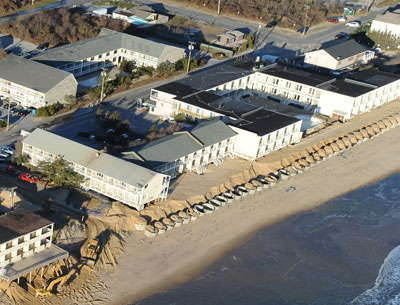Plan to Wall Montauk’s Hotel District

A coastal erosion committee established by the East Hampton Town Board after mega-storm Sandy took a heavy toll in Montauk agreed on Tuesday that nothing — including revetments and other hard structures — should be discounted as an interim means of defending the hamlet’s business district against storm surge until the beach and dunes, which were severely eroded, could be rebuilt. Such an “engineered” beach is expected to make Montauk eligible for the federal help deemed fundamental to covering the immense cost of bringing in enough sand for a long-term effort to protect Montauk from all but the largest storms. The interim measure would include covering hard structures with sand at the expense of shorefront property owners, and it would require that the town’s Local Waterfront Revitalization Program, a state-approved approach to coastal protection, be amended. Bob DeLuca, a member of the committee who is president of the environmental Group for the East End, suggested that a fifth “reach,” specific to Montauk’s ocean beaches, would have to be added to the four existing coastal zones in the L.W.R.P. He said that the L.W.R.P. said further study of the Montauk area was possible. The committee comprises town officials, business owners, and environmental advocates, with Drew Bennett, an engineer, as chairman. It was formed in December and charged with coming up with an approach to deal with downtown Montauk’s vulnerability. The committee’s recommendations, when finalized, will go to the town board. Town Supervisor Bill Wilkinson attended Tuesday’s meeting at Town Hall long enough to report that he had urged Representative Timothy Bishop, State Senator Kenneth LaValle, and Assemblyman Fred W. Thiele Jr. to press the Army Corps of Engineers to allot $20 million to create an engineered beach from Ditch Plain west through Montauk’s downtown, with the goal of obtaining federal aid in the future. Mr. Wilkinson, calling Montauk’s downtown its economic engine, reported that Senators Kirsten Gillibrand and Chuck Schumer and Mr. Bishop had met with Army Corps representatives on Monday. The supervisor also held out the possibility that a share of $53 billion approved by Congress for the reimbursement of losses from Sandy could come to Montauk in the form of a 100-percent grant because the vulnerable area had been part of the Army Corps’ Fire Island to Montauk Reformulation Study, decades in the making and still incomplete. The L.W.R.P. now calls for the relocation of endangered structures in vulnerable areas such as Montauk’s downtown. But committee members agreed that was not the way to go. It also permits the use of geotubes, sand-filled fabric tubes for temporary erosion control, which members said would not be good enough. A fifth reach would allow for engineered beach. While not objecting to revetments for interim protection, Mr. DeLuca voiced concern that it would be hard to make certain they were kept covered with sand, which, he said, was necessary to decrease the potential for beach scouring. Steve Kalimnios, owner of the Royal Atlantic Resort in the downtown area, who installed concrete septic rings in front of the resort after it was nearly toppled by Sandy, suggested that business owners could be required to post bonds that would be forfeited if they failed to keep revetments covered. “If we are afraid of rocks on the beach, it means we don’t believe in the big project,” Mr. Kalimnios said, referring to the eventual rebuilding of downtown beaches and dunes. Diane McNally, a committee member who is the clerk of the town trustees, warned that it was important to look carefully at conditions that might come with federal aid — “how they might impact the rest of town.”
